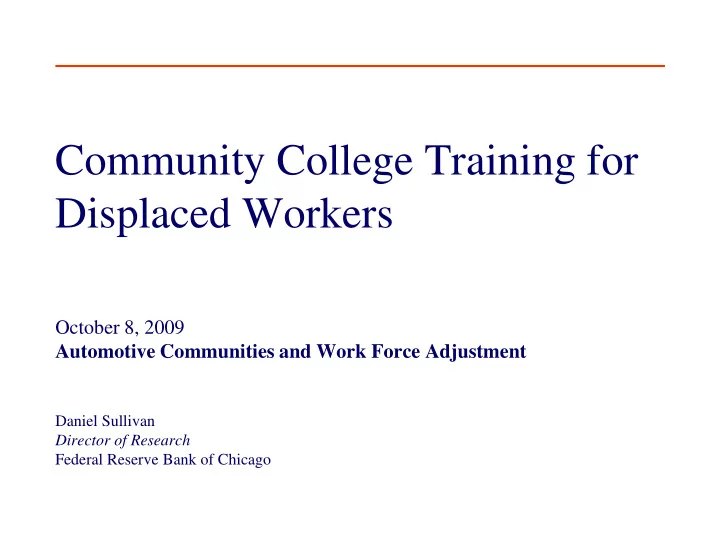

Community College Training for Displaced Workers October 8, 2009 Automotive Communities and Work Force Adjustment Daniel Sullivan Director of Research Federal Reserve Bank of Chicago
My Perspective Based on work with Louis Jacobson (Center for Naval Analysis) and Robert LaLonde (University of Chicago) – “The Impact of Community College Retraining on Older Displaced Workers: Should We Teach Old Dogs New Tricks?” Industrial and Labor Relations Review, Vol. 58, No. 3 (April 2005) – “Is Retraining Displaced Workers A Good Investment?” Chicago Fed Economic Perspectives 2005 Q2 These are my own views – not those of the Federal Reserve Bank of Chicago or the Federal Reserve System
Conclusions Returns to community college training are similar to those for other education – i.e., pretty good – Not necessary to acquire a credential – More limited evidence that older displaced workers can benefit Returns vary by type of course and workers’ prior skills, age, and gender – Those with significant skills deficits are unlikely to benefit Participation patterns are consistent with these impacts – Many displaced workers take just a few classes Training is unlikely to fully offset earnings losses – Offsetting large losses would require large training investments Policy makers should consider other interventions, such as wage insurance for older workers
The Current Context Civilian Unemployment Rate (percent, shading corresponds with NBER recession periods) 21 Michigan National 18 Aug-2009 15 12 Sep-2009 9 6 3 '76 '81 '86 '91 '96 '01 '06 4
Long-term Unemployment Is Extremely High Long-term Unemployed 60 27+ weeks 50 40 Share of Unemployed 15+ weeks 30 20 10 0
Unemployment Rate By Education Level
Unemployment Workers By Education Level
Washington State Study Studied 65,000 workers displaced from jobs in Washington State during the early 1990s – At least three years job tenure – Strong attachment to Washington State labor market Link three sources of administrative data – Wage records from 1987 to 2000 – UI records from 1990 to 1995 – CC transcripts from 1989 to 1996 Types of Credits – Type 1: Health professions, Technical/professional, Technical trades, College level math and science – Type 2: Sales/Service, Other vocational, Social science / Humanities, Health / PE / Consumer ed, Basic skills, Other
Earnings By Quarter Relative to Job Loss
Displaced Workers’ CC Utilization Almost 16% of the displaced workers in our sample completed at least one community college credit Workers with some previous college education were the most likely to get community college training Rates by age and sex: Younger than 35 35 or older Male 16.8% 10.9% Female 23.5% 17.2%
Displaced Workers’ CC Utilization Of those completing at least one credit, the mean credits earned was 26.9 = 0.6 academic years – 45 credits equals one academic year Many who start take very few classes – Roughly 1/3 earn less than 6 credits – Especially among those with poor educational backgrounds Mean credits by age and sex: Younger than 35 35 or older Male 29.5 27.4 Female 27.3 23.5
Earnings Impacts versus Credits We estimate impacts from variation in numbers of credits earned – Also see an effect from “just showing up” Earnings Impact Actual Proportional 0 Credits
Long-Run Earnings Impacts Long-run Impact as a percentage of annual earnings Male Female < 35 ge 35 < 35 ge 35 First Credit 1.9 2.7 -1.5 2.0 Year of Type 1 10.2 7.8 25.3 16.9 Credits Year of Type 2 4.9 2.6 5.8 3.9 Credits
Is Training A Good Investment? Whose perspective? – Workers – Society’s Direct costs of community college education – Often heavily subsidized Opportunity costs of foregone income – Workers’ earnings lower while earning credits – Opportunity costs may be lower when unemployment is high
Cost - Benefit Analysis Assumptions Workers take one academic year of credits over three quarters and then work until age 65 Typical mix of type 1 and type 2 credits None of “just showing up” effect is real benefit Half of the “during CC” impact is a true cost 25% of increased earnings go to taxes CC costs $8,000 -- 20% paid by student
Base-Case Internal Rates of Return Long-run Impact as a percentage of annual earnings Male Female Perspective < 35 ge 35 < 35 ge 35 Individual 13.1% 11.4% 21.2% 15.7% Society 7.4% 3.9% 11.1% 6.2%
Rates of Return Pretty good – Especially for younger workers – Especially for type 1 credits However, – Investment returns less favorable for older workers – Many workers appear unable to complete CC courses Takes substantial investments to offset 25% earnings losses – Roughly 3 years of full-time studies will fully offset losses – Cost = direct + indirect ~$100,000 – Very few get such extensive training Policymakers might consider other forms of assistance
Recommend
More recommend